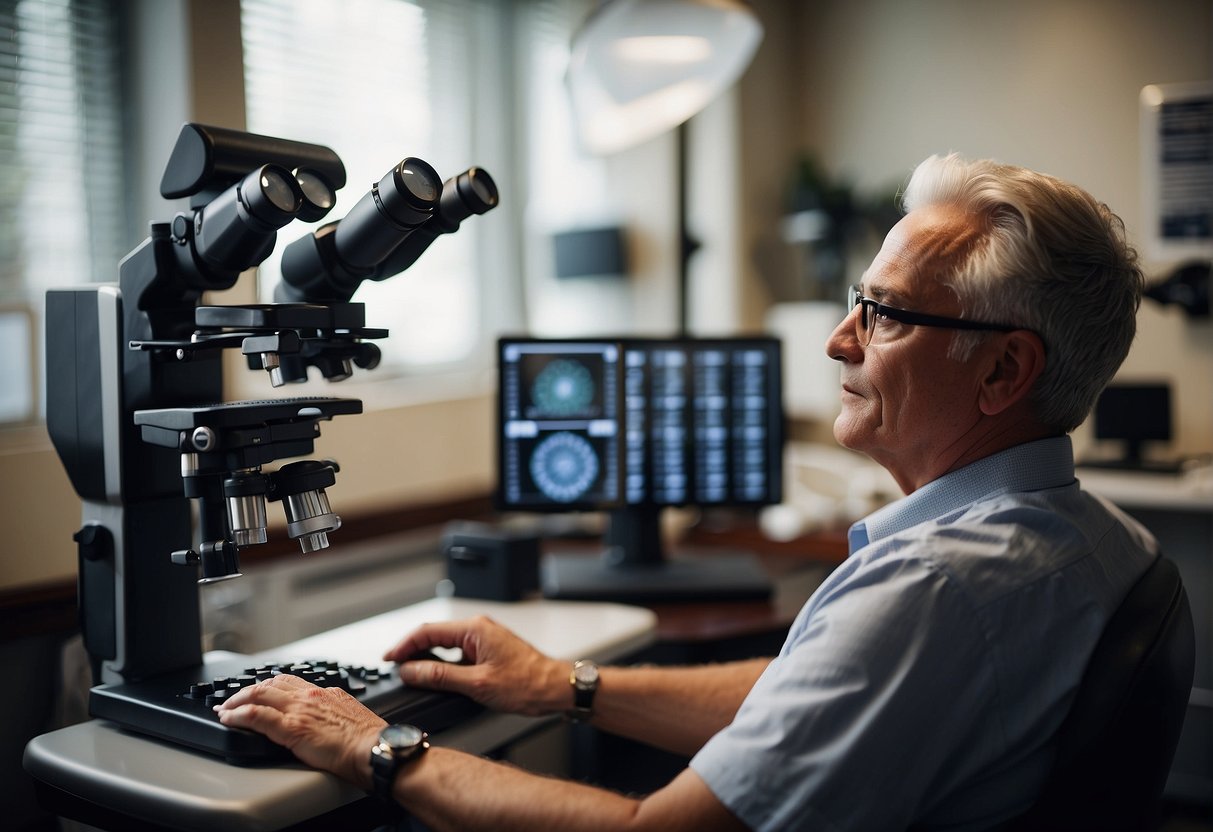
How Much Does an Eye Exam Cost: Factors Affecting Price
Posted by Team Debby on 27th Jan 2024
How Much Does an Eye Exam Cost: Factors Affecting Price
Regular eye exams are crucial for maintaining optimal vision and monitoring eye health.
Many factors can influence the cost of an eye exam. These include location, the eye care provider, and the type of exam.
It can be difficult to estimate the expense without knowing what to expect.
To clarify, the cost of an eye exam can range widely. It can be as little as $50 at a retail store to over $250 for an exam conducted by a specialized ophthalmologist.

Before scheduling an eye exam, it's important to consider whether you have vision insurance. Vision insurance can significantly reduce out-of-pocket expenses.
Insurance may cover a comprehensive portion of the cost or require a copay.
If you don't have insurance, there are various types of service providers to consider, from private practices to optical chains, each with different pricing scales.
Furthermore, the price of an exam can be influenced by the inclusion of contact lens fittings or advanced diagnostic testing.
Additional costs may also arise during an eye exam. These can include the purchase of glasses or contact lenses, and possible treatment for detected eye conditions.
It's beneficial to prioritize eye health and prevention, and budget for potential expenses.
For those with specific visual or medical requirements, the cost may be higher, emphasizing the importance of choosing the right eye care provider to suit individual needs.
Key Takeaways
- Eye exam costs vary widely based on provider, location, and services provided.
- Insurance can greatly reduce the cost, but options still exist for those without coverage.
- Additional expenses should be considered, as they can influence the overall cost of maintaining eye health.
Understanding Eye Exam Costs

When considering an eye exam, we must be aware of various factors that can affect the cost, as well as what one might typically expect to pay.
Factors Influencing Eye Exam Price
The price of an eye exam can vary widely. One primary factor is the location of the service. Eye exams in urban centers or areas with higher living costs tend to be more expensive.
The type of provider also matters. Optical chains might offer lower prices due to their scale, while independent optometrists could charge more.
Whether the exam is a comprehensive eye exam that checks for all aspects of your eye health or a basic vision test also influences the price.
Vision insurance is another critical factor. Those with insurance may pay a significantly reduced rate or none at all, depending on their coverage.
We must also consider the experience of the eye care professional. Seasoned optometrists may charge more for their expertise.
Average Cost of Eye Exams
To provide a specific outlook, we've gathered some data on the average cost of eye exams.
Without vision insurance, the price can range broadly. Here is a general breakdown:
- Optical chains and retail stores: $50 - $70
- Private practice optometrists: $100 - $150
- Ophthalmologists: Typically higher, especially for comprehensive exams
The costs above are without insurance. For those with vision insurance, the co-pay for an eye exam might be as low as $10 to $40, depending on the plan.
It is imperative for us to check with our insurance provider to understand our coverage benefits before scheduling an exam.
Insurance and Vision Coverage

When planning for an eye exam, understanding the intricacies of insurance and vision coverage is key to estimating costs effectively. Let's explore the details of health and vision insurance, and what you might expect to pay out of pocket.
Health Insurance and Eye Care
Health insurance policies can be complex, and coverage for eye care specifically often depends on the nature of the plan.
In many cases, health insurance may cover eye exams if they're considered a medical necessity. Conditions such as diabetes or a high risk of glaucoma could make an exam medically necessary.
However, routine eye exams might not be covered.
Providers like the Affordable Care Act plans often include pediatric vision coverage, but adult vision coverage is not a requirement.
Vision Insurance Plans
Vision insurance plans like VSP and Humana Vision provide specific vision coverage that typically includes routine eye exams, glasses, and contact lenses.
These plans operate as either benefits or discount plans. A benefits plan might cover the full cost of an exam, subject to a copay, while a discount plan may provide reduced rates for services.
It is important to check with individual vision insurance companies for specific plan details, as coverage can vary widely.
Out-of-Pocket Expenses
If you do not have vision insurance or if your health insurance doesn't cover a routine eye exam, you will likely need to pay out-of-pocket.
Prices can vary significantly by provider and location but tend to range from $50 to $250 for a basic eye exam without insurance.
Those costs can increase if additional tests are required.
Our careful attention to these aspects of insurance and vision coverage will aid us in making informed decisions regarding eye care expenses.
Types of Eye Exams and Services

When we talk about eye exams, it's important to distinguish between routine and comprehensive exams, as well as specialized examinations and services that cater to specific ocular health issues.
Regular Versus Comprehensive Eye Exams
Regular eye exams are basic checks that assess the health of our eyes and the quality of our vision.
These typically involve a discussion of our medical history, a vision acuity test using an eye chart, and may include a pressure test for glaucoma. We might receive a refraction assessment, which determines our prescription for eyeglasses or contact lenses.
On the other hand, comprehensive eye exams are more in-depth and evaluate the overall health of our eyes, including the detection of potential eye diseases.
Key components of a comprehensive eye exam may include pupil dilation to examine the retina and optic nerve, a visual field test to check for peripheral vision issues, and retinoscopy to observe how our eyes react to light, which helps to estimate our prescription.
Specialized Examinations and Services
We also provide specialized care for patients who have specific vision problems or eye health concerns. These services include but are not limited to:
- Visual field testing: Used to map and measure the scope of what we can see peripherally and centrally, which is vital for diagnosing and monitoring glaucoma and other pathologies.
- Specialized care for conditions: Such as diabetic retinopathy, macular degeneration, and cataracts, which require targeted testing and management strategies beyond routine care.
- Pediatric exams and geriatric services: Tailored to meet the unique vision care needs of children and the elderly, including screenings for common developmental or age-related ocular conditions.
Choosing an Eye Care Provider

When selecting an eye care provider, we consider the differences between optometrists and ophthalmologists, as well as choosing between retail and independent providers.
It's essential for us to understand these distinctions to make an informed decision that meets our vision health needs.
Optometrists and Ophthalmologists
Optometrists are eye care professionals who can perform eye exams, prescribe corrective lenses, and diagnose and manage certain eye conditions. They hold a Doctor of Optometry (OD) degree.
Ophthalmologists are medical doctors who specialize in eye and vision care. They can perform the same services as optometrists but also have the training to carry out eye surgery and treat more complex eye diseases.
- Optometrists: Focus on routine eye care and vision correction.
- Ophthalmologists: Handle complex eye care, including surgeries.
When choosing between the two, it's crucial to consider the specific eye care needs we have.
For regular eye exams and glasses prescriptions, an optometrist is sufficient. However, for surgical procedures or treatment of serious eye conditions, we should seek the services of an ophthalmologist.
Retail vs Independent Providers
Retail eye care providers are commonly found in shopping centers and include chains like LensCrafters, Walmart, and Target.
They often offer convenient locations and hours, and sometimes, more competitive pricing.
- Pros of Retail Providers:
- Extended hours and accessibility.
- Potentially more affordable options.
- Cons of Retail Providers:
- May have a faster turnover of staff.
- Can be perceived as less personalized care.
Independent optometrists may operate within their own practice or team up with a group of eye care professionals.
They might not have the branding of larger chains like Costco but can provide a personalized service that builds on long-term patient relationships.
- Pros of Independent Providers:
- Can offer a more personalized care experience.
- May provide continuity with the same provider over time.
- Cons of Independent Providers:
- Potentially higher costs for services.
- May have more limited hours than retail providers.
Additional Costs and Considerations

When considering the overall cost of an eye exam, we must account for potential additional expenses such as eyewear or special deals that could affect the final price.
Glasses and Contact Lenses
After an eye exam, purchasing glasses or contact lenses can significantly increase the total cost.
For glasses, the price varies based on frame materials, lens types, and any additional coatings, like anti-reflective or scratch-resistant coatings.
Standard lenses can start as low as $40, while progressive lenses typically range from $80 to $250.
Contact lenses entail recurring costs, with a box of six disposable lenses starting around $22-$26, while specialized contacts, like toric lenses for astigmatism, may cost more.
Discounts and Package Deals
Discounts can greatly reduce eyewear and eye exam expenses. Many optometrists offer package deals that include the eye exam and a pair or pairs of glasses at a reduced rate.
For instance, we might find offers like "Buy one get one free" on frames or inclusive deals with lenses. Various insurances also provide discounts on both eye exams and eyewear purchases.
It's critical to inquire about potential deals or insurance coverage, as this could save us a considerable amount of money on our optical needs.
Eye Health and Prevention

In this section, we address the importance of recognizing common eye conditions and the role of regular eye exams in early detection. Our goal is to provide you with information to support the health and longevity of your vision.
Common Eye Conditions and Diseases
We often encounter a variety of eye conditions that can impact our quality of life.
Refractive errors such as nearsightedness (myopia), farsightedness (hyperopia), and astigmatism are common issues that affect our ability to see clearly at various distances.
Cataracts—the clouding of the eye's lens—are another prevalent condition, particularly in the aging population.
More serious diseases like macular degeneration, which leads to vision loss in the center of the visual field, and glaucoma, a group of eye conditions that damage the optic nerve, are critical to identify early. Regular monitoring can prevent progression towards blindness.
Regular Eye Exams and Early Detection
We can't overstate the significance of regular eye exams for the early detection of potential problems.
An eye exam can reveal the early stages of many eye troubles, allowing for prompt and often more effective treatment.
For instance, catching glaucoma early can mean the difference between preserving sight and facing significant vision loss.
Similarly, early signs of macular degeneration or cataracts can be monitored and managed, with surgery being a potential recommendation if appropriate.
Even less severe issues, like eye strain, can be addressed during an exam, with recommendations made to reduce symptoms.
Through these proactive measures, we safeguard our eye health and take a crucial step in prevention.
Frequently Asked Questions

We understand that cost is an important consideration when scheduling an eye exam. Below are specific answers to the most common questions about eye exam costs at various providers.
What are the typical prices for an eye exam at major retailers like Walmart?
At Walmart, the cost of an eye exam typically ranges from $60 to $90, depending on the location and the complexity of the exam required.
Can you provide the average cost of an eye exam with vision insurance?
With vision insurance, an eye exam cost can be significantly reduced, often ranging from a $10 to $40 copay, depending on the insurance plan's specifics.
What is the price range for eye exams at optical chains like Costco?
Optical chains like Costco generally offer eye exams for between $70 to $100, although prices can vary based on the optometrist and the type of exam.
How much does an ophthalmologist charge for an eye examination?
Ophthalmologists typically charge $100 to $250+ for an eye examination. These costs reflect the specialized nature of care and tests performed by an ophthalmologist, which often go beyond standard vision exams.
What is the cost variation for eye exams across different regions in the U.S.?
Eye exam costs can vary by region within the U.S. Typically, urban areas with higher costs of living may charge upwards of $200, while rural areas might have lower prices closer to $50 - $80.
What are the expected fees for a basic eye test at optometry practices not affiliated with retail chains?
At independent optometry practices, a basic eye exam may cost between $50 to over $150. The cost can vary based on the optometrist's location, the services provided, and the practice's policies.

